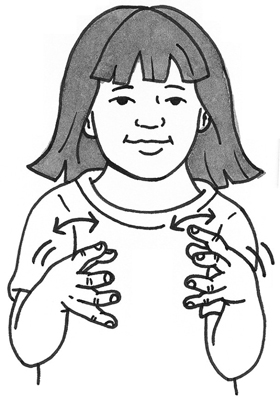Sign Language is the perfect way to help the communication process along with your children.
Many kids are able to sign long before they can speak!
This post will cover tips on using sign language with your children, instructions on how to sign some early and everyday signs, and my recommended home video's.
Many kids are able to sign long before they can speak!
This post will cover tips on using sign language with your children, instructions on how to sign some early and everyday signs, and my recommended home video's.
Tips on Using Sign Language
Keep these tips in mind as you and your child begin using signs.
Use signs that are useful for your child and a part of his life.
If the signs aren't useful, your child won't learn them or use them.
Be sure that you have your child's attention when you sign to him or show him signs.
Use the sign and word(s) together.
Repeat words verbally after your child signs them to reinforce the spoken word.
Use the signs that your child is learning in as many situations as possible.
Your child needs to see a sign many times and understand them before he will try to sign them.
Accept your child's signing attempts and try not to over-correct.
As your child begins to use signs, he may have difficulty making the sign because he can't form his hands in the shape of the sign.
Try not to anticipate your child's needs before he does.
Leave enough time for your child to recognize and express his need to communicate.
Start teaching as early as 6 months.
You can start signing when your baby is between 6 and 8 months and holds your gaze for a few seconds.How to Sign Early and Everyday Signs
Eat/Food: close your fingers to your thumb and tap fingertips against your lips
More: close your fingers to your thumb (on both hands) and tap fingertips together.
Drink: Position hand like it is holding a cup, and "take a drink"
Finished / All Done: Hands out with palms facing you - then turn them over so palms face away
Please: Palm rubs on chest in circle
Thank You
Thank You / Your Welcome: Move open hand from your chin, going down
Play: Both hands with thumb and pinkie outstretched, and shake
Ball
Ball: Claw hands to form a ball shape. Rotate hands alternately.
Stop: One hand moves down and is stopped by the other hand (palm up)
Help: Thumbs up on top of one hand, and move them both up
Mom: Outstretched hand, thumb taps your chin
Dad: Outstretched hand, thumb taps your forehead
Signing Time
If you are unfamiliar with the Signing Time Series, it is definitely worth checking out (see the links to Amazon on the right hand side bar as well).
They are 30 minute dvd's that teach children how to sign.
They are 30 minute dvd's that teach children how to sign.
My boys LOVE them, and they were an absolute life saver with Cannon - if they impact Lincoln half as much as they did him I will be a happy mama.





















